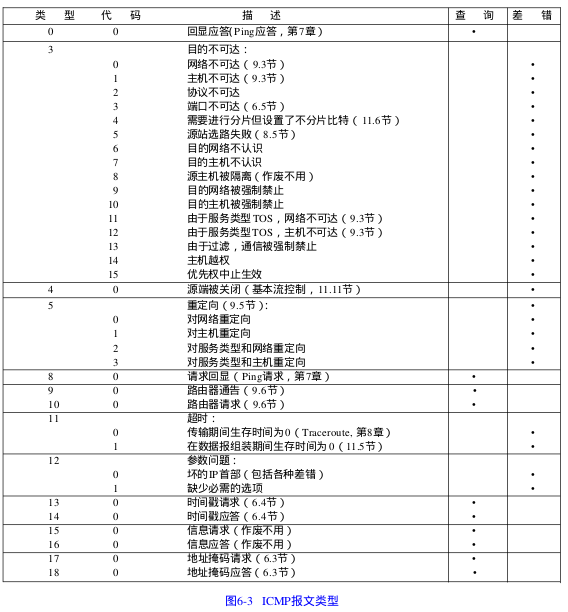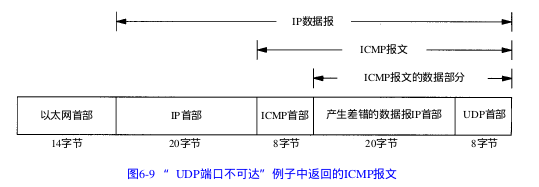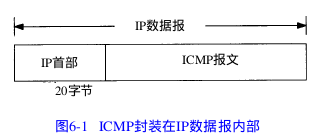1. ICMP基础知识
ICMP经常被认为是IP层的一个组成部分。它传递差错报文以及其他需要注意的信息。ICMP报文通常被IP层或更高层协议(TCP或UDP)使用。一些ICMP报文把差错报文返回给用户进程。
1) ICMP报文的类型

而具体的类型和代码如下:

在对ICMP差错报文进行响应时,永远不会生生成另一份ICMP差错报文(否则会无休止的产生差错报文)。下面这种情况都不会导致产生ICMP差错报文:
1) ICMP差错报文(ICMP查询报文可能会产生ICMP差错报文)
2) 目的地址是广播地址或者多播地址的IP数据报
3) 作为链路层广播的数据报
4) 不是IP分片的第一片
5) 源地址不是单个主机的数据报。这就是说,源地址不能为零地址,环回地址,广播地址或多播地址。
这些规则是为了防止过去允许ICMP差错报文对广播分组响应所带来的广播风暴
2. ICMP地址掩码的请求与应答/ICMP时间戳请求与应答
这部分直接看代码,会比较直观一些:

icmpaddrmask.c:
/*
* Issue an ICMP address mask request and print the reply.
*
* This program originated from the public domain ping program written
* by Mike Muuss.
*
* You must be superuser to run this program (or it must be suid to root)
* since it requires a raw socket.
*/
#include <sys/types.h>
#include <sys/param.h>
#include <sys/socket.h>
#include <sys/file.h>
#include <sys/time.h>
#include <sys/signal.h>
#include <netinet/in_systm.h>
#include <netinet/in.h>
#include <netinet/ip.h>
#include <netinet/ip_icmp.h>
/* #include <netinet/ip_var.h> */
#include <netdb.h>
#include <unistd.h>
#include <stdio.h>
#include <ctype.h>
#include <errno.h>
#include <string.h>
//DEFDATALEN为子网掩码的请求报文长度(类型(1字节) + 代码(1字节) + 校验和(2字节) + 标识符(2字节) + 序列号(2字节) + 32位子网掩码(4字节))
#define DEFDATALEN (12) /* default data length */
#define MAXIPLEN 60 //IP数据报的最大长度(因为胃4bit,最大为15,所以共有15 * 32bit(IP首部长度)共60字节)
#define MAXICMPLEN 76 //为什么ICMP的最大长度为76
#define MAXPACKET (65536 - 60 - 8)/* max packet size */
struct sockaddr whereto; /* who to send request to */
int datalen = DEFDATALEN;
int s;
u_char outpack[MAXPACKET];
char *hostname; //存储输入的IP地址(点分十进制)
u_long inet_addr();
char *inet_ntoa();
void sig_alrm(int);
int response = 0;
main(argc, argv)
int argc;
char **argv;
{
int i, ch, fdmask, hold, packlen, preload;
extern int errno;
struct hostent *hp;
struct sockaddr_in *to;
struct protoent *proto;
u_char *packet;
char *target, hnamebuf[MAXHOSTNAMELEN], *malloc();
if (argc != 2)
exit(1);
target = argv[1];
bzero((char *)&whereto, sizeof(struct sockaddr));
to = (struct sockaddr_in *)&whereto;
to->sin_family = AF_INET;
/* try to convert as dotted decimal address,
else if that fails assume it's a hostname */
to->sin_addr.s_addr = inet_addr(target);
//说明target是一个IP地址
if (to->sin_addr.s_addr != (u_int)-1)
hostname = target;
else {
//说明target是一个域名或主机名
hp = gethostbyname(target);
if (!hp) {
fprintf(stderr, "unknown host %s\n", target);
exit(1);
}
to->sin_family = hp->h_addrtype;
bcopy(hp->h_addr, (caddr_t)&to->sin_addr, hp->h_length);
strncpy(hnamebuf, hp->h_name, sizeof(hnamebuf) - 1);
hostname = hnamebuf;
}
packlen = datalen + MAXIPLEN + MAXICMPLEN; //=12 + 60 + 76
if ( (packet = (u_char *)malloc((u_int)packlen)) == NULL) {
fprintf(stderr, "malloc error\n");
exit(1);
}
if ( (proto = getprotobyname("icmp")) == NULL) {
fprintf(stderr, "unknown protocol icmp\n");
exit(1);
}
if ( (s = socket(AF_INET, SOCK_RAW, proto->p_proto)) < 0) {
perror("socket"); /* probably not running as superuser */
exit(1);
}
/*
* We send one request, then wait 5 seconds, printing any
* replies that come back. This lets us send a request to
* a broadcast address and print multiple replies.
*/
signal(SIGALRM, sig_alrm);
alarm(5); /* 5 second time limit */
sender(); /* send the request */
for (;;) {
struct sockaddr_in from;
int cc, fromlen;
fromlen = sizeof(from);
if ( (cc = recvfrom(s, (char *)packet, packlen, 0,
(struct sockaddr *)&from, &fromlen)) < 0) {
if (errno == EINTR)
continue;
perror("recvfrom error");
continue;
}
procpack((char *)packet, cc, &from);
}
}
/*
* Send the ICMP address mask request.
*/
sender()
{
int i, cc;
struct icmp *icp;
//所发送的ICMP地址掩码请求数据(后期可指定标识符icmp_id和序列号icmp_seq来把应答和请求相匹配)
icp = (struct icmp *)outpack;
icp->icmp_type = ICMP_MASKREQ; //地址掩码请求
icp->icmp_code = 0; //代码为0
icp->icmp_cksum = 0; /* compute checksum below */
icp->icmp_seq = 12345; /* seq and id must be reflected */ //序列号
icp->icmp_id = getpid(); //标识符---之所以把进程ID设置为标识符,因为同时运行的程序组不可能存在进程ID相同的两个进程
icp->icmp_mask = 0;
cc = ICMP_MASKLEN; /* 12 = 8 bytes of header, 4 bytes of mask */
/* compute ICMP checksum here */
icp->icmp_cksum = in_cksum((u_short *)icp, cc);
//往指定的目的地址whereto发送ICMP地址掩码请求
i = sendto(s, (char *)outpack, cc, 0, &whereto,
sizeof(struct sockaddr));
if (i < 0 || i != cc) {
if (i < 0)
perror("sendto error");
printf("wrote %s %d chars, ret=%d\n", hostname, cc, i);
}
}
/*
* Process a received ICMP message.
*/
procpack(buf, cc, from)
char *buf;
int cc;
struct sockaddr_in *from;
{
int i, hlen;
struct icmp *icp;
struct ip *ip;
struct timeval tvdelta;
/* Check the IP header */
ip = (struct ip *)buf;
hlen = ip->ip_hl << 2; //得到IP数据报的长度(IP数据报的前两个字节为:版本 + IP首部长度)
if (cc < hlen + ICMP_MINLEN) {
fprintf(stderr, "packet too short (%d bytes) from %s\n", cc,
inet_ntoa(*(struct in_addr *)&from->sin_addr.s_addr));
return;
}
/* Now the ICMP part */
cc -= hlen;
icp = (struct icmp *)(buf + hlen);
/* With a raw ICMP socket we get all ICMP packets that
come into the kernel. */
//如果得到的是子网掩码的应答
//不知道为什么ICMP_MASKREPLY的值不等于17
if (ICMP_MASKREPLY != 17)
printf("error!\n");
if (icp->icmp_type == 17) {
if (cc != ICMP_MASKLEN)
printf("cc = %d, expected cc = 12\n", cc);
//判断序列号是否一致
if (icp->icmp_seq != 12345)
printf("received sequence # %d\n", icp->icmp_seq);
//判断标识符是否一致
if (icp->icmp_id != getpid())
printf("received id %d\n", icp->icmp_id);
//如果标识符一致并且序列号一致,则打印其子网掩码和地址
printf("received mask = %08x, from %s\n",
ntohl(icp->icmp_mask),
inet_ntoa(*(struct in_addr *) &from->sin_addr.s_addr));
response++;
}
/* We ignore all other types of ICMP messages */
}
/*
* in_cksum --
* Checksum routine for Internet Protocol family headers (C Version)
*/
in_cksum(addr, len)
u_short *addr;
int len;
{
register int nleft = len;
register u_short *w = addr;
register int sum = 0;
u_short answer = 0;
/*
* Our algorithm is simple, using a 32 bit accumulator (sum), we add
* sequential 16 bit words to it, and at the end, fold back all the
* carry bits from the top 16 bits into the lower 16 bits.
*/
while (nleft > 1) {
sum += *w++;
nleft -= 2;
}
/* mop up an odd byte, if necessary */
if (nleft == 1) {
*(u_char *)(&answer) = *(u_char *)w ;
sum += answer;
}
/* add back carry outs from top 16 bits to low 16 bits */
sum = (sum >> 16) + (sum & 0xffff); /* add hi 16 to low 16 */
sum += (sum >> 16); /* add carry */
answer = ~sum; /* truncate to 16 bits */
return(answer);
}
void
sig_alrm(int signo)
{
if (response == 0) {
printf("timeout\n");
exit(1);
}
exit(0); /* we got one or more responses */
}root@ThinkPad-T430i:/home/leichaojian# ./icmpaddrmask 192.168.0.5
error!
received mask = 00000000, from 192.168.0.5
3. ICMP端口不可达
UDP的规则之一是:如果收到一份UDP数据报而目的端口与某个正在使用的进程不相符,那么UDP返回一个ICMP不可达报文,可以用TFTP来强制生成一个端口不可达报文。
leichaojian@ThinkPad-T430i:~$ tftp
tftp> connect svr4 8888
tftp> get temp.foo
Transfer timed out.
我们执行如下命令:
root@ThinkPad-T430i:/home/leichaojian# tcpdump -e > temp.foo20:51:54.096199 00:21:cc:cc:05:d4 (oui Unknown) > c8:3a:35:64:96:d8 (oui Unknown), ethertype IPv4 (0x0800), length 62: 192.168.0.5.45810 > 218.30.64.194.8888: UDP, length 20
20:51:59.096378 00:21:cc:cc:05:d4 (oui Unknown) > c8:3a:35:64:96:d8 (oui Unknown), ethertype IPv4 (0x0800), length 62: 192.168.0.5.45810 > 218.30.64.194.8888: UDP, length 20
20:52:04.096526 00:21:cc:cc:05:d4 (oui Unknown) > c8:3a:35:64:96:d8 (oui Unknown), ethertype IPv4 (0x0800), length 62: 192.168.0.5.45810 > 218.30.64.194.8888: UDP, length 20
20:52:09.096700 00:21:cc:cc:05:d4 (oui Unknown) > c8:3a:35:64:96:d8 (oui Unknown), ethertype IPv4 (0x0800), length 62: 192.168.0.5.45810 > 218.30.64.194.8888: UDP, length 20
而ICMP不可达报文的一般格式如下:


























 1653
1653











 被折叠的 条评论
为什么被折叠?
被折叠的 条评论
为什么被折叠?








